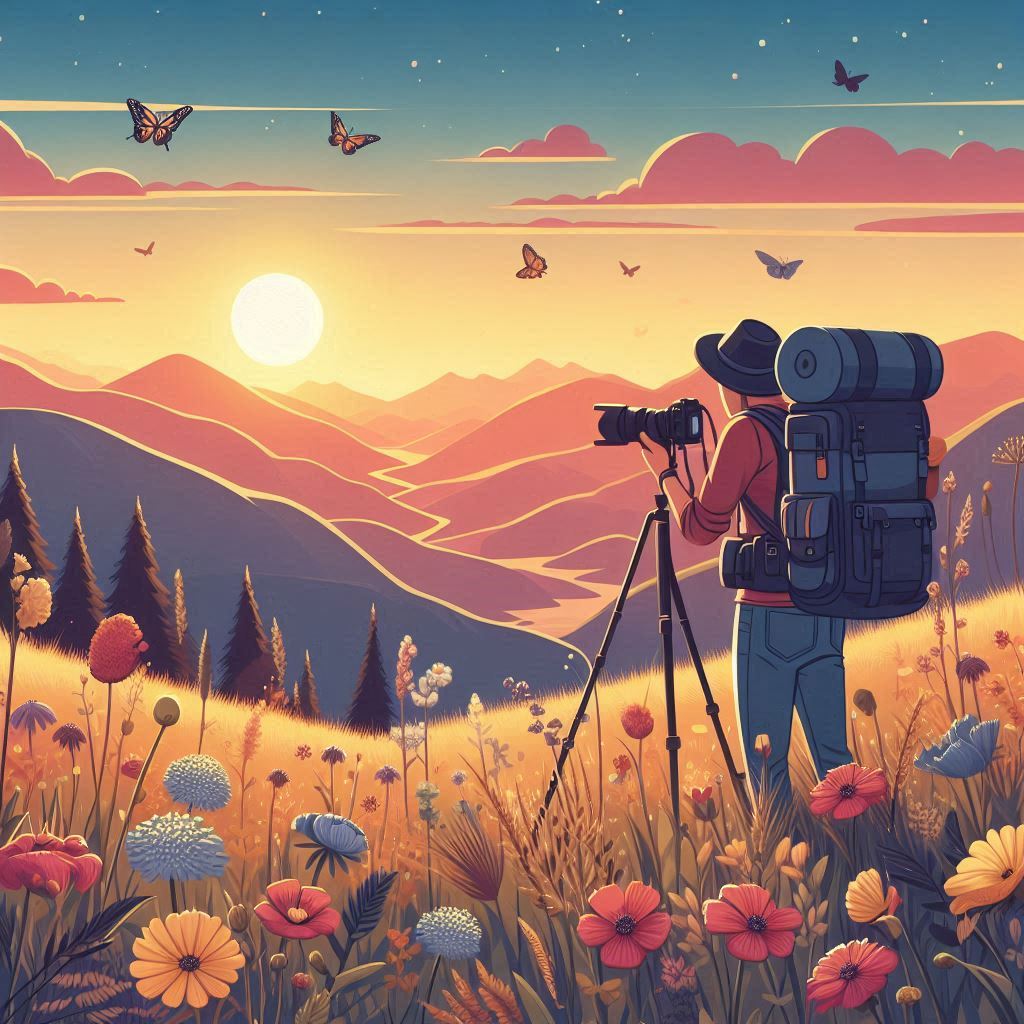
Every budding photographer must grasp the basics of camera settings. This knowledge is foundational for taking better photos and unlocking the full potential of your camera. At the core of this are three key settings: ISO, Shutter Speed, and Aperture, collectively known as the Exposure Triangle.
The first element, ISO, controls the camera’s sensitivity to light. A lower ISO (like 100 or 200) is best for bright conditions, giving you clear, crisp images with less noise. Higher ISO settings (like 1600 or above) brighten up shots taken in low light but can introduce graininess or noise to your photos.
Shutter Speed
Next, shutter speed is all about the length of time your camera’s sensor is exposed to light. A fast shutter speed (like 1/1000th of a second) can freeze action, ideal for sports photography. A slower shutter speed (like 1/30th of a second) can capture motion blur, which can be used artistically, especially in low-light conditions.
Aperture
Aperture, measured in f-stops (like f/2.8, f/5.6, etc.), controls the amount of light entering the lens and affects the depth of field. A lower f-stop (like f/1.8) means a wider aperture, allowing more light in and creating a shallow depth of field. This makes your subject stand out against a blurry background. A higher f-stop (like f/16) narrows the aperture, letting less light in but giving greater depth of field, keeping more of the scene in focus.
Understand These Settings
Understanding how these three settings interact is crucial. For example, if increasing the shutter speed makes your image too dark, you might need to increase the ISO or open up the aperture to let in more light. Practicing this balance will help you adapt to different shooting conditions and improve your photography skills.
Here are some simple tips to get started: start with your camera on auto mode to see how it handles different situations. Then, switch to manual and try adjusting one setting at a time, observing the effects on your images. Over time, playing around with these settings will make you more confident and intuitive in making adjustments.
The Power of Composition
Composition is a fundamental aspect of photography that dictates how elements are arranged within a frame. Mastering composition can turn a simple photo into a captivating piece of art. The Rule of Thirds is a great starting point. Imagine breaking your image down into nine equal parts by two equally spaced horizontal lines and two equally spaced vertical lines. Ideally, you should place the most important elements along these lines or at their intersections, which naturally draws the viewer’s eye.
Leading lines, such as roads, rivers, or fences, guide the viewer’s eyes through the image. They can add depth and a focal point to your photos. Look for natural or man-made lines that you can incorporate into your shots to create a sense of direction or flow.
Balance and Symmetry
Balance and symmetry offer another layer of compositional strength. Symmetrical shots have subjects mirrored on either side of a central line, creating harmony and balance. Though symmetry can be pleasing, it’s also worth exploring asymmetrical compositions for more dynamic and interesting photos.
Negative space refers to the empty areas around or between the subjects in your image. This space helps to emphasize your main subject and can make your photos feel less cluttered and more focused. Experiment with leaving significant parts of your frame empty to highlight your subject better.
To practice composition, take multiple shots of the same scene, each time shifting where you place different elements according to the rules mentioned above. Compare your photos to see which composition works best. Over time, composing shots will become second nature, making your photos more engaging.
Lighting: The Key to Creating Mood and Atmosphere
In photography, lighting is everything. It can shape the mood, reveal textures, and add depth to your photos. Understanding how to use both natural and artificial light effectively is essential for any beginner.
Natural light, like sunlight, can be incredibly flattering. Morning and late afternoon, known as the golden hours, provide soft, warm light that is perfect for portraits and landscape shots. These times minimize harsh shadows and offer a more balanced exposure. The blue hour, the short window right after sunset or before sunrise, offers cooler tones and a magical atmosphere for cityscapes and twilight scenes.
Artificial Light
Artificial light, such as lamps, flash, and studio lights, gives you greater control over your lighting conditions. Experimenting with these can dramatically change the look and feel of your photos. For instance, using a softbox can diffuse harsh light, making it softer on the subject’s face. On the other hand, a flash can help you freeze motion in low-light environments but needs to be used carefully to avoid harsh shadows and overexposure.
Manipulating light is crucial in setting the mood. For dramatic effects, backlighting can create silhouettes and add a sense of mystery. Side lighting can enhance textures and add depth, especially useful in portrait and still-life photography. Reflectors can bounce light back onto your subject, softening shadows and highlighting details.
For beginners, practicing with different light sources and angles is key. Start by photographing subjects at various times of the day to understand how natural light changes. Use simple tools like a desk lamp or a flashlight to experiment with artificial lighting. By becoming familiar with how light interacts with subjects, you’ll be better equipped to capture stunning photos that convey the desired mood and atmosphere.
The Role of Color: Enhancing Emotion and Depth
Color is a powerful tool in photography that can evoke emotions, set the scene, and add layers of meaning to your images. To effectively use color, you should first understand some basics of color theory. Knowing how different colors interact can help you make intentional choices that enhance your photos.
Complementary colors, like blue and orange or red and green, are opposite each other on the color wheel and create high contrast and visual interest when used together. These color combinations can make your subjects pop and add vibrancy to your images.
Contrasting colors, on the other hand, can evoke different emotions. Warm colors like red, yellow, and orange often convey energy and warmth. Cool colors like blue and green can create a calming or sad mood. By mixing these colors intentionally, you can guide your viewer’s emotional response.
What Affects The Mood?
The color temperature of light affects the overall mood of your photo as well. Warm tones (yellow/orange) often make a photo feel more inviting and cozy, while cool tones (blue) can add a sense of tranquility or even solitude. Pay attention to the light source’s color temperature when taking your shots to maintain the intended mood.
Experimenting with color is a great way to improve your photography skills. Start by focusing on a single color to make it the main subject of your photo. Look for color contrasts in everyday scenes, or try shooting the same subject under different lighting conditions to observe how colors change. This hands-on practice will deepen your understanding and ability to use color creatively.
Capturing the Moment: Genuine Emotion and Expression
Great photos often capture more than just a scene; they capture a feeling. Genuine emotion and expression can turn a simple snapshot into a memorable image. Making your subjects feel comfortable is crucial for capturing authentic moments. Start by chatting with them before the shoot to break the ice. This helps them relax and act naturally in front of the camera.
Candid shots are another excellent way to capture real emotions. Instead of directing every move, observe and photograph your subjects as they interact with their environment or each other. These unposed moments can often reveal the most genuine expressions and tell a compelling story.
Timing is everything in photography. Being patient and ready to press the shutter at the right moment can make all the difference. Whether it’s a fleeting smile, a tear, or a spontaneous laugh, these moments require you to be attentive and quick. Carry your camera with you often to practice catching these split-second emotions.
Take Multiple Shots
To ensure you’re capturing the right expression, take multiple shots. Shooting in burst mode can be helpful, allowing you to choose the best frame later. Over time, you’ll develop an instinct for predicting and capturing these moments naturally.
Remember, photography is not just about the technical aspects; it’s also about connecting with your subject and creating an environment where genuine emotions can flourish. This blend of technical skill and emotional connection will help you capture images filled with authenticity and life.
Post-Processing: Refining Your Images
Post-processing is the final step in creating beautiful photos. While capturing a good photo with a camera is important, editing allows you to enhance and perfect your images. Beginners often overlook this stage, but with a few basic techniques, you can significantly improve your work.
Start with basic edits like adjusting brightness, contrast, and saturation. These simple tweaks can make your photos pop and look more balanced. Experiment with the white balance to correct any color casts and enhance the natural tones of your image.
Cropping is another easy yet powerful tool. It allows you to reframe your composition and eliminate distracting elements. A well-cropped image focuses the viewer’s attention on the main subject and follows the rules of composition more closely.
Try A Beginner-Friendly Editing Software
Using free or beginner-friendly editing software can make this process accessible without overwhelming. Programs like GIMP, Darktable, or even mobile apps like Snapseed offer a range of tools to get you started. As you become more comfortable, you might explore more advanced software like Adobe Lightroom or Photoshop.
It’s essential to approach post-processing ethically. Aim to enhance the existing elements of your photos, not to deceive. Over-editing can make your images look unnatural, so strike a balance that preserves the authenticity of your shot.
Final Thoughts
Practical practice: edit a batch of photos with the same techniques to maintain a consistent style. Over time, you’ll develop a signature editing style that complements your photography. Don’t be afraid to experiment, but always remember that less is often more in post-processing. Now get out there and start shooting!!!
Did you enjoy this post? Do you want to know when the next post comes out? Consider subscribing. I only send update emails once a week, usually on Friday. Try it out. You can unsubscribe at any time.
